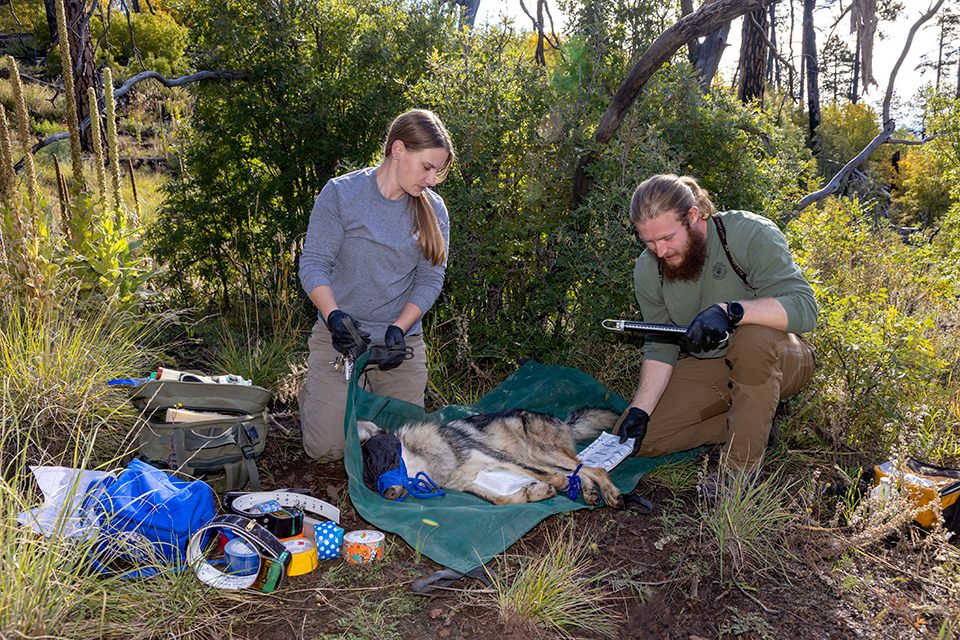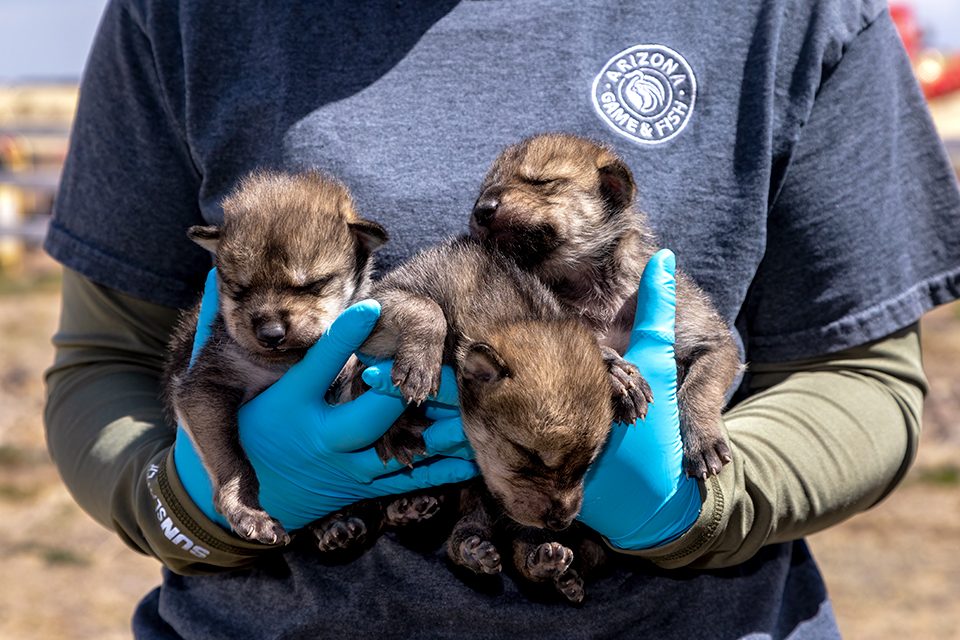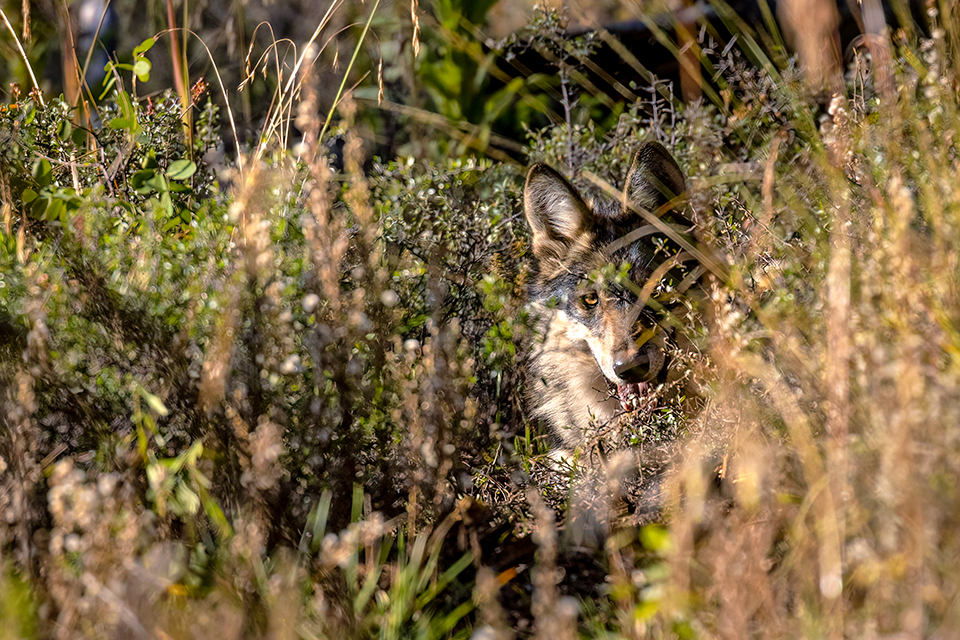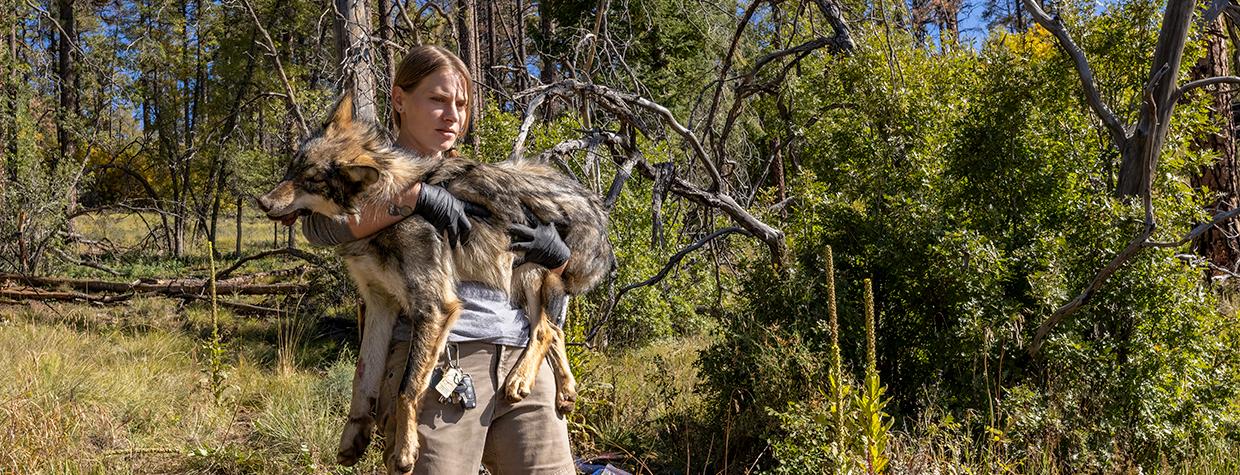Bailey Dilgard has a dead porcupine in the bed of her truck.
That’s one of the things I notice when I accompany her down a remote, rutted road in the Apache-Sitgreaves National Forests south of Vernon. The porcupine’s sharp quills, she explains, were no match for a car tire on State Route 260, the main east-west route through Eastern Arizona’s White Mountains. When she saw the roadkill, she picked it up to keep other animals from scavenging it and meeting the same fate.
Dilgard emphasizes that carrying around dead porcupines isn’t a requirement of her job. But it isn’t out of character for someone drawn to working as a wolf biologist for the Arizona Game and Fish Department. On this warm June morning, we’re out amid the oaks and tall pines to see if Mexican wolves, the focus of Dilgard’s work for the past three years, have recently visited this part of the forest.
Mexican wolves once occupied a wide swath of the Southwest, but eradication efforts left them nearly extinct in the wild by the 1970s. Today, 25 years after reintroduction of the wolves began, Canis lupus baileyi, the smallest and rarest subspecies of the gray wolf in North America, is regaining its place on the landscape. In 2022, a minimum of 241 wild wolves were documented in Eastern Arizona and Western New Mexico, marking the first time that population had surpassed 200. An innovative management technique is boosting the wolves’ long-term prospects. And Dilgard and her four-person team are doing everything they can to make this species a lasting part of Arizona’s ecosystem once again.
“It’s a challenging position,” says Dilgard’s supervisor, Paul Greer. “There’s stress and conflict in a number of different places, so we have a high level of turnover — it’s just the nature of the program. And to have somebody like Bailey, who enjoys it and really thrives and does well on that, we don’t take that for granted.”
Farther down the forest road, Dilgard and frequent work companion Siggy, an energetic border collie/blue heeler mix, trek 50 feet off the road to a Game and Fish motion-activated camera padlocked to a ponderosa pine. She pulls the camera’s memory card, plugs it into an adapter on her iPhone and starts flipping through photos to see which animals sat for a portrait session over the past week. There was a large bull elk, then several birds. And then, two days ago, a young black bear spent most of the day nosing around and investigating the camera.
Sometimes, Dilgard says, she’ll find a photo of a bear or mountain lion from just minutes earlier. But not today — and the camera hasn’t captured any wolves. She’ll keep looking for them. It’s what she does. What’s less predictable is how she does it. “It’s not the same thing on repeat every day,” she says. “For me, this is the most ideal work environment I could be in.”

Take a deep breath before picturing this: You squeeze yourself into a 2-foot-wide opening under a rock slab in the middle of the forest. Then, you belly-crawl 20 feet through a narrow tunnel, take a sharp left turn and drop 4 feet into an underground opening — where, by the way, there’s a small chance you might encounter a 70-pound Mexican wolf.
“It’s not for somebody who’s claustrophobic,” Dilgard says, dryly. But she considers “den diving” a highlight of her work. It’s part of a process called cross-fostering, in which genetically valuable captive-born wolf pups are placed with wild wolves that have litters of their own. Doing so increases the genetic diversity of the population while giving the pups the benefits of growing up in the wild — including a natural fear of humans, which helps head off cattle depredations and other nuisance behavior.
But den diving is one of the last steps in the process. Before that are weeks of logistics to monitor whelping and match the captive-born pups with a suitable den — which is tricky, given that both sets of pups must be under 14 days old and no more than eight days apart. Dilgard and her team spend a lot of their time monitoring captive and wild packs to find potential fits.
Once there’s a match, “that’s when the chaos starts,” she says. Equipment and personnel have to be ready to go, and everything must have its scent removed to keep the mother wolf from abandoning the den. The pups have to be flown in from the captive facility where they were born, tube-fed every two to four hours, evaluated by a veterinarian and hiked into the field. Then it’s a matter of finding the den, which could be shallow and easy to access — or require a lot of crawling. “There’s a ton of variation, and it’s all dependent on that female,” Dilgard says.
Generally, the mother wolf clears out when Dilgard and her team approach the den. (Being surprised by another adult wolf inside the den, while possible, is rare and has never happened to Dilgard.) The wild pups are taken out, examined, implanted with a microchip and swabbed for later genetic analysis, and all the pups are stimulated to urinate on each other to make them all smell the same. Then they’re put back into the den, and after the team leaves, the mother returns — and, if all goes well, adopts the captive-born pups as her own.
It’s an intense undertaking, but the reasons for doing it have become obvious since Game and Fish and the department’s partner agencies began cross-fostering wolves in 2016. Typically, about half of wild-born wolves survive to their breeding age of 2, and Greer says the cross-fostered wolves appear to be surviving at the same rate. So far, biologists have documented at least 15 cross-fostered Mexican wolves that have reached breeding age.
One of those survivors is Wolf AM1471, a male cross-fostered from Chicago’s Brookfield Zoo in 2016. That wolf went on to form the Prime Canyon Pack, and by the end of 2022, it had produced five litters — and five of its offspring had also become “alphas” and produced litters of their own. “It’s neat now, with some time behind us, to really see the success of it,” Greer says. “As a team, we look forward to the cross-fostering season. When you’ve done it and you’re walking away from the den, you really feel like you’ve done something for conservation.”

The work comes naturally to Dilgard, who grew up in the Phoenix area, in a family of outdoors enthusiasts. “As a child, I kind of just ran around in the forest,” she recalls. “We would go camping all the time, and my mom would be like, ‘Have fun. Be free.’ ” Summer vacation and other breaks from school, she says, became times to escape the heat and be in nature: “When you live in the desert, it’s nice to not look at the desert.”
A love of wild places and wild things took hold, and by the time she went to college, Dilgard knew the path she wanted to follow. She earned a bachelor’s degree in natural resources, with an emphasis on wildlife management and conservation, from the University of Arizona, then interned with Game and Fish’s contracts branch before being hired on as a seasonal technician.
Early on, Dilgard worked on projects that examined highway impact on animals and the effectiveness of wildlife crossings on those roadways, and then on recovery projects for three of the state’s endangered species: northern Mexican garter snakes, flat-tail horned lizards and Mount Graham red squirrels. “It really gave me a look at all the different things I could be doing: herpetology work, or something more urban-based, or something that’s a little bit more secluded,” she says. “And after experiencing all these different projects, I realized large mammals were definitely the way for me — as much as I like reptiles and amphibians and fish, I definitely prefer the furry, fuzzy things.”
So, when she saw a job opening for a wolf technician, she went for it, thinking the worst thing that could happen was that she wouldn’t get it. But she did. And before long, she’d been promoted to wolf biologist. “I just continue to grow in this role,” she says. “It’s been incredibly rewarding. This job is by no means mundane, and you never do the same thing twice.”
Depending on the time of year, when Dilgard isn’t belly-crawling into a den, you might find her counting wolves on the ground or from a helicopter, jumping out of a chopper to retrieve a tranquilized animal or coordinating the deployment of tracking collars. The latter, she says, “is a lot of fun, because it takes some strategizing. You’re really trying to … I don’t want to say ‘think like a wolf,’ but in some aspects, you are, in terms of reading signs and figuring out where these wolves are traveling so you can capture them and go hands-on with them.”
Greer says Dilgard’s ability to adapt and prioritize has made her an asset to the program. “Bailey is really strong with the stakeholders, and she’s got really good integrity and interpersonal skills,” he adds. “There’s a lot of trust that she’s developed. It’s not uncommon for me to be talking with some livestock producers, or whomever, and hear very good feedback about Bailey, how she presents herself and her transparency.”
Those interactions sometimes include diplomatically addressing myths about Mexican wolves. Someone might say they saw a white wolf, or a black one, when in reality, there’s no solid white or solid black color variation in the subspecies. Or that the wolves grow to 100 pounds or larger, rather than their typical 50 to 70. Or that they kill things simply for pleasure, which simply doesn’t happen. Dilgard has heard it all. But she knows dealing with it is an important part of her role.
“You’re building those relationships with [livestock] permittees or members of different communities,” she says. “And being able to help them, being able to reduce that impact … I don’t want to say it’s enjoyable, because nobody wants to address or be dealing with conflict, but it is fulfilling in its own way.”

We’re done checking the camera, on which Dilgard hoped she might spot members of the Pancho Spring Pack. That pack’s two adult wolves recently produced their first litter, and Dilgard wants to determine the routes the pack is using for travel. The lack of wolf photos isn’t a huge surprise, though: Dilgard suspects this pack might be using a different corridor, where other cameras are in use.
Before we leave, Dilgard makes a few phone calls about another roadkill victim: a deer found this morning near Becker Lake, northwest of Springerville. The team plans to employ it for conflict mitigation, using the carcass to draw wolves away from pastures occupied by cattle. Next, we head south of Pole Knoll, in the Greer area, to see if the wolves have been bothering a cattle herd.
Tattoos on Dilgard’s right forearm honor two of her dogs that have died, and now, she has Siggy and four others. Her husband, who works for a different agency, has work dogs, too. And at their home in Eagar, they have Pickles the goat and a 700-pound steer they’ve raised for the past two years, since it was a 2-day-old orphaned calf.
I ask if the steer has a name, and Dilgard laughs before answering. “We have a family friend,” she says, “who told us that you shouldn’t name an animal you’re going to eat, but if you do, you should name it after food. So, we named him Porterhouse. He goes by Porter.” She pauses for a minute as she considers Porter’s eventual embodiment of his name. “That’s gonna be hard,” she admits. “I’m the type of person who gets really attached to animals when I have them as pets.”
It’s different, though, with the animals that are the focus of her working hours. Call it the difference between a personal relationship and a professional one. “You want to see these wolves on the landscape be successful,” she says. That’s because she and her program are working toward a goal spelled out by a federal recovery plan: the removal, someday, of Mexican wolves from the endangered species list. Successes are celebrated, but in nature, death is as constant a presence as life.
“The example of [Wolf] AM1471 — that has been an exciting story,” she adds. “Watching that individual wolf continue to contribute to the population … I think it’s awesome. So, when the day comes when he’s no longer a part of the population … I mean, yeah, it’s going to be kind of a bummer. Just because he has contributed so much. But so have so many other wolves.”
We reach the cattle herd, and after Dilgard surveys it with binoculars from the road, we trek down a hill to check on a calf that at first isn’t moving but turns out to be taking a morning snooze. Dilgard points out a newly installed row of red flags on a fence bordering the pasture. The flags, part of a strategy called fladry, take advantage of wolves’ natural wariness of unfamiliar things to keep them away from the cattle. They’re one of many tools Dilgard and her team can use to help the wolves — and the livestock that share the forest with them.
Later today, Dilgard will work on a draft of a quarterly update to help share the program’s progress with the community. There’s an annual report, too. And always, there are wolves to track and count, conflicts to mitigate, pups to hike to a den where they’ll get a shot at life in the place their ancestors once roamed for thousands of years.
And, at some point, she’ll have to do something about that porcupine.
Wolves and You
There’s never been a confirmed Mexican wolf attack on a person in the wild, and in general, wolves are naturally wary of people and keep their distance. Given that — and the relatively low number of wolves now in Arizona — it’s unlikely you’ll see one while hiking or otherwise recreating in their territory. But if you do, and if the wolf stands its ground or approaches you, the Arizona Game and Fish Department recommends you maintain eye contact with it and act unafraid. Aggressively lunge toward the wolf while yelling, clapping or making other loud noises, and appear as large and threatening as possible. Then, retreat slowly while facing the wolf and continuing to act aggressively. Do not purposely attract, seek out or chase wolves, and never feed wolves or other wildlife. Report any wolf encounter to Game and Fish (623-236-7201) or the U.S. Fish and Wildlife Service (505-761-4704).

